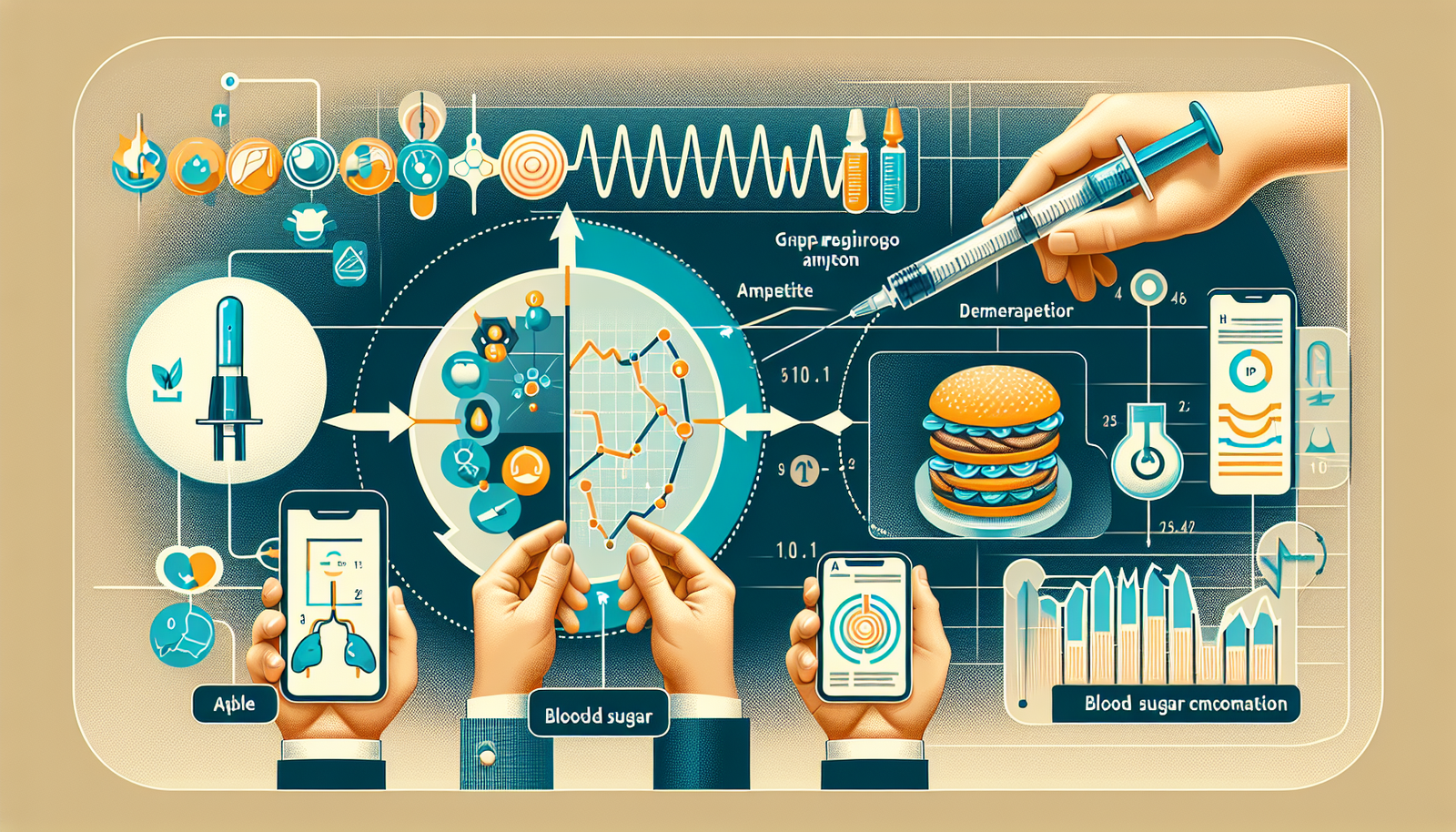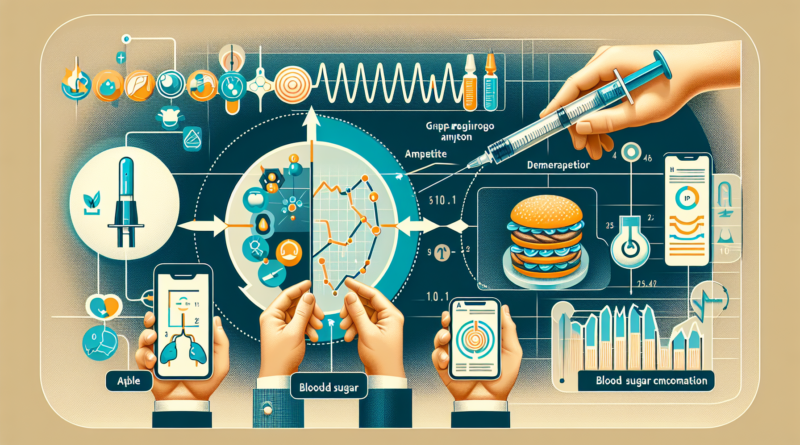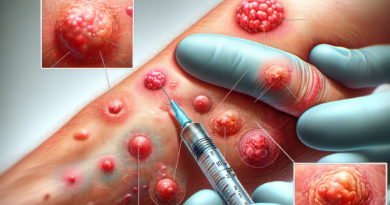Understanding the Effect of GLP-1 Receptor Agonist Injections on Appetite and Blood Sugar Levels
Imagine sitting down to your favorite meal but feeling full even before you’ve eaten much and not craving the extra servings you usually indulge in. The article “Understanding the Effect of GLP-1 Receptor Agonist Injections on Appetite and Blood Sugar Levels” sheds light on how glucagon-like peptide-1 (GLP-1) receptor agonists work to get this kind of reaction. These injections not only curb your usual cravings and manage your glucose levels but also slow down your gastric emptying, making you feel satisfied sooner and extending the feeling of fullness. If you’ve ever wondered about the science behind these injections, this article is an interesting peek into some of their underlying effects.

Overview of GLP-1 Receptor Agonist Injections
Definition of GLP-1 receptor agonists
GLP-1 receptor agonists are a class of injectable drugs designed to manage blood sugar levels in individuals with diabetes, particularly type 2 diabetes. They work by imitating the functions of glucagon-like peptide-1 (GLP-1), a hormone naturally produced in your gut after you eat.
How GLP-1 receptor agonists work
GLP-1 receptor agonists work in a few ways. They promote insulin secretion from the pancreas, curtail the release of glucose from the liver, and delay the stomach’s emptying process. Additionally, they interact with the brain’s satiety center, helping to reduce feelings of hunger and increase feelings of fullness.
Common types of GLP-1 receptor agonists
There are several types of GLP-1 receptor agonists available, including exenatide, liraglutide, and semaglutide. Each type has its own mechanism and dosage recommendations. Your doctor will determine the most suitable one for you based on your medical history and lifestyle.
GLP-1 and Blood Sugar Regulation
Role of GLP-1 in blood sugar level management
The hormone GLP-1 plays an integral part in managing blood sugar levels. It triggers insulin production when glucose levels rise, ensuring that extra glucose is absorbed into your body’s cells for energy usage, thus maintaining balance.
How GLP-1 receptor agonists affect blood glucose levels
GLP-1 receptor agonists mimic the actions of natural GLP-1. They promote insulin production, suppress glucagon release, and slow gastric emptying. This ultimately results in more stable and lower blood glucose levels, especially after meals.
Impact on insulin and glucagon secretion
GLP-1 receptor agonists have a dual effect on insulin and glucagon. They stimulate insulin production, crucial for directing glucose from the bloodstream into the cells, and simultaneously suppress the secretion of glucagon, a hormone that raises blood glucose levels.
GLP-1 Receptor Agonists’ Impact on Appetite
GLP-1 effect on gastric emptying
GLP-1 has a slowing effect on gastric emptying. It can delay the stomach’s emptying process, resulting in a prolonged feeling of fullness, which in turn reduces your food intake.
Impact on the satiety center in the brain
GLP-1 receptor agonists also interact with the satiety center in your brain, making you feel satiated after consuming less food, hence reducing your overall food intake and aiding weight loss efforts.
Resulting changes in food intake and cravings
Overall, due to their impact on gastric emptying and the satiety center in the brain, GLP-1 receptor agonists can help you manage your food intake better while curbing cravings and reducing the temptation to overeat.
Benefits of GLP-1 Receptor Agonist Treatment
Weight management benefits
Apart from their blood sugar regulation benefits, GLP-1 receptor agonists are also known for their role in weight management. By slowing gastric emptying and reducing appetite, they can help people maintain or reduce their weight effectively.
Benefits for diabetes management
In diabetes management, GLP-1 receptor agonists play an essential role. They help regulate blood sugar levels, reduce hypoglycemia risks compared to other diabetes medications, and can encourage weight loss, a common challenge for many with diabetes.
Potential improvements in cardiovascular health
There’s emerging evidence that GLP-1 receptor agonists may also provide cardiovascular benefits. Some studies suggest they can reduce risks of major cardiovascular events in patients with type 2 diabetes. However, further research is required to fully substantiate these findings.
Potential Side Effects of GLP-1 Receptor Agonist Treatment
Common side effects
Like all medications, GLP-1 receptor agonists can have side effects. Common ones include nausea, vomiting, and diarrhea. Thankfully, these side effects typically subside over time as your body adjusts to the medication.
Case studies on severe side effects
While uncommon, some severe side effects have been reported. These include pancreatitis and allergic reactions. If you have severe abdominal pain or symptoms of an allergic reaction, seek medical attention immediately.
Managing side effects
If side effects persist, consult a healthcare professional. They may be able to adjust your dosage or recommend effective coping strategies. It’s crucial to have open communication with your healthcare team about any side effects you may be experiencing.
Clinical Studies and Evidence
Key clinical trials on GLP-1 receptor agonists
Numerous clinical trials have been conducted on GLP-1 receptor agonists. These studies have underpinned the efficacy of these medications in improving glycemic control, promoting weight loss, and potentially benefiting cardiovascular health.
Study outcomes on blood sugar regulation
Most research studies show significant improvements in blood glucose levels. Patients experienced lower fasting glucose levels, post-meal glucose levels, and overall blood glucose levels, confirming the effectiveness of GLP-1 receptor agonists in managing diabetes.
Research on appetite control benefits
Research also highlights the role of GLP-1 receptor agonists in reducing food intake and encouraging weight loss, demonstrating their value both in diabetes management and weight control.
Comparing GLP-1 Receptor Agonist Treatment with Other Treatments
Comparison with insulin injections
Compared to insulin injections, GLP-1 receptor agonists offer a lower risk of hypoglycemia and weight gain. However, they are typically used when oral medications and lifestyle adjustments are not sufficient or for those who can’t take other types of diabetes drugs.
Differences with oral antidiabetic drugs
Unlike oral antidiabetic drugs, GLP-1 receptor agonists are injected and typically have fewer side effects. They also provide additional benefits like appetite control and weight management that most oral medications cannot offer.
Analysis of combined therapy approaches
Many times, GLP-1 receptor agonists are used in combination with other diabetes management options, such as diet, exercise, and other medications, for a more holistic treatment approach.
Patient Experiences with GLP-1 Receptor Agonists
Patient testimonials about appetite control
Many patients report feeling fuller and experiencing less hunger and cravings when on GLP-1 receptor agonist medications. These feelings often contribute to better management of food intake and assist in achieving weight loss and health goals.
Reports on blood sugar management
User reports commonly highlight the effectiveness of GLP-1 receptor agonists in blood sugar management, with many patients experiencing more stable glucose levels throughout the day.
Discussion on lifestyle adjustments
However, like any medication, GLP-1 receptor agonists may necessitate certain lifestyle adjustments. These could involve adjusting meal timings to match medication administration and monitoring blood sugar levels regularly, among other changes.
Best Practices in GLP-1 Receptor Agonist Treatment
Ideal candidates for the treatment
GLP-1 receptor agonists are often prescribed for type 2 diabetes patients who can’t control their blood sugar levels through lifestyle changes or oral medications alone. However, the ultimate decision rests with your doctor who will consider your overall health, lifestyle, and medication tolerance.
Timing and dosage considerations
The timing and dosage of GLP-1 receptor agonist injections are patient-specific and should be discussed with your healthcare provider. It’s crucial to adhere to their guidance strictly to ensure optimal outcomes.
Importance of ongoing monitoring and adjustments
Once on GLP-1 receptor agonists, it’s crucial to have regular check-ups and blood tests to monitor your blood sugar levels and possibly adjust your medication dosage or timing as necessary.
Future Research Directions for GLP-1 Receptor Agonists
Potential new uses of GLP-1 receptor agonists
There’s ongoing research into new uses for GLP-1 receptor agonists, with promising areas including obesity management, non-alcoholic fatty liver disease, and cardiovascular health.
Upcoming clinical trials
Several clinical trials are currently underway, aiming to delve deeper into the benefits and mechanisms of GLP-1 receptor agonists. These studies are expected to provide valuable insights into their future use.
The future of GLP-1 in diabetes treatment
As our understanding of GLP-1 and its functionality develops, so too will our use of GLP-1 receptor agonists. They are already a powerful tool in diabetes treatment, and their role seems likely to expand as we learn more about their potential benefits and applications.




